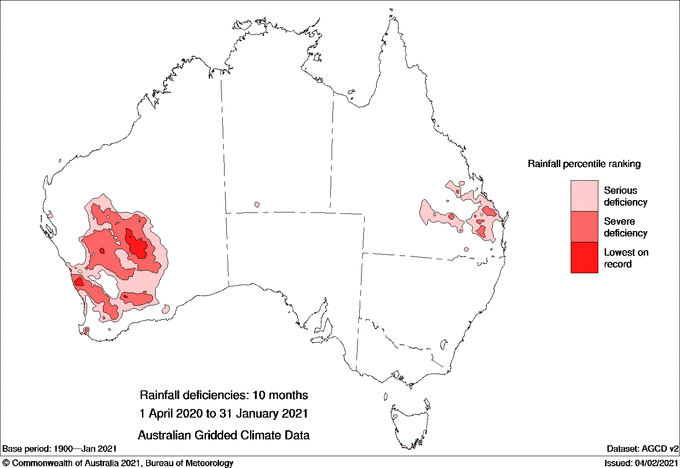
SERIOUS or severe rainfall deficiencies for the 10-month period April 2020–January 2021 are in place in a large area of Western Australia, covering parts of the central South West Land Division, the eastern half of the Gascoyne, and the west of the Goldfields District.
Deficiencies remain similar to the previous nine-month period, with little rain falling in January in what is a seasonally dry time of the year for the South West Land Division, according to the Bureau of Meteorology’s latest drought statement.
In eastern Australia, rainfall deficiencies have again contracted in Queensland, although serious or severe rainfall deficiencies continue in parts of the greater southeast of the state, covering the Wide Bay and Burnett District, extending in some areas north to around Rockhampton and inland to around Tambo and Charleville.
Some areas of southern inland Queensland received above average rainfall for January.
Extended dry conditions over eastern Australia
Australia has experienced a prolonged period of below average rainfall spanning several years.
Rainfall deficiencies have affected much of Australia since January 2017. Multi-year rainfall deficiencies and their impact on the Murray–Darling Basin are discussed in Special Climate Statement 70 and the dry conditions over Eastern Australia for the period commencing January 2018 are described in Special Climate Statement 66.
The strip along the west coast and south coast of WA has also been affected by rainfall deficiencies for the periods commencing January 2017 and January 2018.
For periods longer than 24 months, the greatest impact of the prolonged below average rainfall has been in the cooler months of April to October.
Large parts of the country remain in severe rainfall deficiency for the 34-month period from April 2018 to January 2021, though rainfall last year and in early 2021 has seen improvement across many areas.
Above-average January rainfall eased longer-term deficiencies slightly in parts of the southeast, most notably over north eastern Victoria and southern to central New South Wales.
However, in inland Western Australia rainfall deficiencies generally increased compared to the same period ending December 2020.
Persistent, widespread, above average rainfall is needed to lift areas out of deficiency at annual and longer timescales and provide relief from the impacts of this long period of low rainfall (such as renewing water storages).
The impact of the longer dry on water resources is still evident, especially in northern parts of the Murray–Darling Basin where total storage levels remain low.
The role of climate change in rainfall reduction over southern Australia and along the Great Dividing Range is discussed in State of the Climate 2020.
Parts of south west, south east, and eastern Australia—including parts of south east Queensland and southern and eastern NSW—have seen substantial declines in cool-season rainfall in recent decades.
Source: BOM

HAVE YOUR SAY